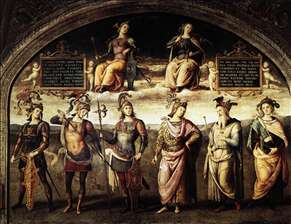Pietro Perugino (Pietro Vannucci), Italian painter, active mainly in Perugia. from which his nickname derives. His early career is obscure, but he seems to have formed his styte chiefly in Florence, where
Vasari says he studied with
Verrocchio - this would have been at about the same time that
Leonardo da Vinci was training with him (another tradition has it that Perugino was a pupil of Piero della Francesca ; this could have preceded his training in Florence). In 1472 he was enrolled as a painter in the fraternity of St Luke in Florence (the same year as Leonardo) and in 1475 he was back in Perugia.
By 1481 he was sufficiently well known to be commissioned to paint frescos on the walls of the newly built Sistine Chapel, Rome, along with
Botticelli, Domenico Ghirlandaio, and
Cosimo Rosselli (
Signorelli later completed the work).
Vasari says that Botticelli was head of the team, but some modern scholars think that Perugino was more likely to have been leader, partly because of the prominence of his contributions. His main work there is Christ Delivering the Keys to St Peter ; he also did the frescoed altarpiece, but this was destroyed to make way for Michelangelo s Last Judgment.
His reputation firmly established, he travelled extensively in central Italy, and in the 1490s he maintained a workshop in Florence as well as in Perugia. In 1500, when he was decorating the Audience Chamber of the Collegio del Cambio at Perugia, he was called by Agostino Chigi, the wealthy Sienese banker and patron, the best painter in Italy, and he was indeed at his peak at about this time.
Perugino was a fine portraitist as well as a fresco painter, but today he is best known for his altarpieces, which are usually gentle, pious, and rather sentimental in manner. His style does not seem to have been a reflection of his personality, for
Vasari says he was not a religious man and that he would have gone to any lengths for money . In about 1505 he left the competitive atmosphere of Florence, where his work now seemed old-fashioned, and settled permanently in Perugia; his later work is often routine and repetitive. At his best, however, as in the Vatican fresco, he has the authority of a great master. The harmony and spatial clarity of his compositions and his idealized physical types had great influence on the young
Raphael, who worked with him early in his career, so Perugino can be seen as one of the harbingers of the High Renaissance. A second wave of his influence came in the 19th century, when he was glorified by the Pre-Raphaelites.









